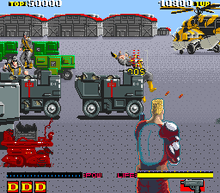Dynamite Duke
Dynamite Duke (Japanese: ダイナマイトデューク, Hepburn: Dainamaito Dūku) is a 1989 action arcade game developed by Seibu Kaihatsu. It was later ported to the Master System, Mega Drive/Genesis and X68000. Being a Cabal-based shooter, it can be considered a follow-up to Seibu's Empire City: 1931 and Dead Angle.
| Dynamite Duke | |
|---|---|
 Japanese arcade flyer of Dynamite Duke. | |
| Developer(s) | Seibu Kaihatsu (arcade) Whiteboard (SMS) |
| Publisher(s) | Seibu Kaihatsu (arcade) Sega (SMS, Genesis) |
| Platform(s) | Arcade, Mega Drive/Genesis, Master System, X68000 |
| Release | Arcade 1989 Master System 1989 Mega Drive/Genesis [1]
|
| Genre(s) | Shooting gallery |
| Mode(s) | Single player |
The Double Dynamites
| The Double Dynamites | |
|---|---|
| Developer(s) | Seibu Kaihatsu |
| Publisher(s) | |
| Platform(s) | Arcade |
| Release | 1989-? |
| Genre(s) | Action |
| Mode(s) | Single player, multi-player (max 2) |
It is a version with simultaneous 2 player support. In addition, there are other changes:
- Life gauges are shown with visible bars, where Duke and bosses all have 11 bars of life.
- In the English version, it is no longer possible to refill the life bar by adding credits after completing Mission 1.
- With the exception of Mission 9, there are more enemies on screen, including boss battles.
- In the high score entry screen, a countdown timer is shown.
Story

A top scientist decides to utilise a secret formula to develop his very own army of evil mutant warriors, so he can become the ruler of the world. It is up to Dynamite Duke: a man who is armed with a cybernetic arm along with a machine gun to foil his evil plan.
Gameplay

The Arcade version has 9 stages, while the Genesis version only has 6 stages.
Receptions
Mean Machines gave the Mega Drive/Genesis version a 79%, commenting that it was only visually better than the Master System version and that it "lacks lasting appeal."[2] Levi Buchanan of IGN rated the Genesis game a 5.0 (Meh) for a dismal value, 30 minutes of play value.[3]
References
- "MD/GEN Release dates". GameFAQs. Retrieved 2008-02-13.
- Dynamite Duke review - Mega Drive
- Dynamite Duke Review - Horrible box art, horrible Genesis game.
External links
- The Arcade version of Dynamite Duke can be played for free in the browser at the Internet Archive
- Dynamite Duke at MobyGames